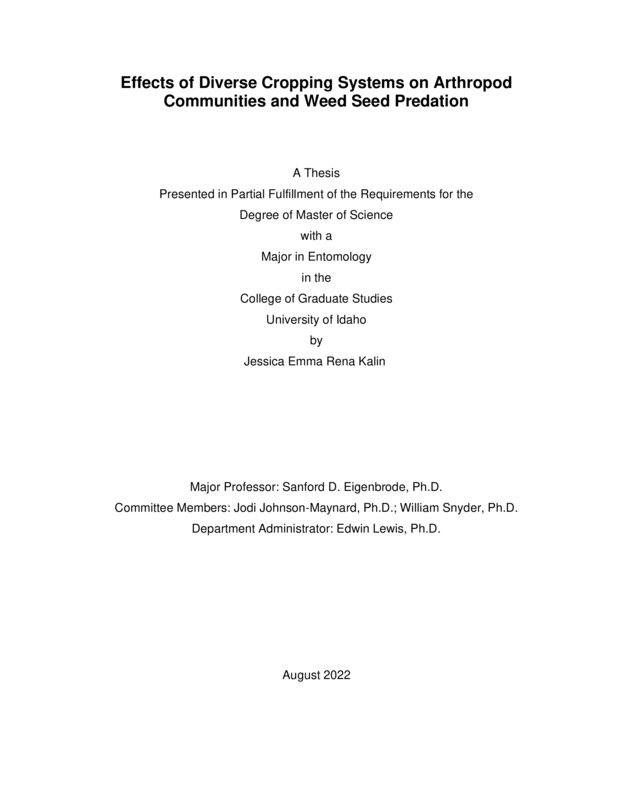Effects of Diverse Cropping Systems on Arthropod Communities and Weed Seed Predation
Kalin, Jessica Emma Rena. (2022-08). Effects of Diverse Cropping Systems on Arthropod Communities and Weed Seed Predation. Theses and Dissertations Collection, University of Idaho Library Digital Collections. https://www.lib.uidaho.edu/digital/etd/items/kalin_idaho_0089n_12431.html
- Title:
- Effects of Diverse Cropping Systems on Arthropod Communities and Weed Seed Predation
- Author:
- Kalin, Jessica Emma Rena
- Date:
- 2022-08
- Keywords:
- aboveground arthropods diversification granivores intensification weed seed predation
- Program:
- Entomology, Plant Path & Nematology
- Subject Category:
- Entomology
- Abstract:
-
Projected and ongoing climate change presents challenges and opportunities for wheat-based cropping systems throughout the inland Pacific Northwest (iPNW). Producers are interested in reducing the amount of land in fallow to increase overall crop production, as well as create more sustainable cropping systems that are resilient to a projected variable climate. Examples of crop rotation diversification and intensification for wheat systems include the addition of pulse crops such as dry pea and chickpea, and multi-species cover crops into rotations. Monitoring arthropod community responses to diversification and intensification can inform producers on which alternative crops are also associated with increased biodiversity and arthropod-mediated ecosystem services, such as pollination and biological control. Biological control of weedy pests in fields is a key ecosystem service provided predominately by epigeic arthropods and small mammals. The work presented here examines epigeal arthropod community structure and weed seed predation under three diversified and intensified wheat-based cropping systems at two trial locations. Results show that epigeal activity-density and diversity were greatest in winter pea plots compared to the other crops tested. Granivore community metrics were not affected by crop or sampling date at the St. John, Washington site but at the Genesee, Idaho site, winter pea consistently had greater diversity and activity-density compared to winter wheat. Generally, activity-density and diversity were greater in the crops unique to diversified rotations, though evenness was greater in winter wheat plots than in winter pea or cover crop plots. Weed seed removal was greater in fallow plots than in plots planted to any crop. Removal rates differed among four sample dates but there was no seasonal trend or interaction between sample date and crop. In weed seed preference trials, Anthemis cotula was consumed at significantly lower rates than Bromus tectorum or Chenopodium album, but when physical defenses (seed coverings) were artificially breached, A. cotula was consumed at higher rates than B. tectorum. Diversified wheat cropping systems in the iPNW either reduce or remove fallow from rotation, which could lead to increased weed abundance in seed banks, exacerbating weed management problems in these systems.
- Description:
- masters, M.S., Entomology, Plant Path & Nematology -- University of Idaho - College of Graduate Studies, 2022-08
- Major Professor:
- Eigenbrode, Sanford D.
- Committee:
- Johnson-Maynard, Jodi; Snyder, William E.; Lewis, Edwin
- Defense Date:
- 2022-08
- Identifier:
- Kalin_idaho_0089N_12431
- Type:
- Text
- Format Original:
- Format:
- application/pdf
- Rights:
- In Copyright - Educational Use Permitted. For more information, please contact University of Idaho Library Special Collections and Archives Department at libspec@uidaho.edu.
- Standardized Rights:
- http://rightsstatements.org/vocab/InC-EDU/1.0/

